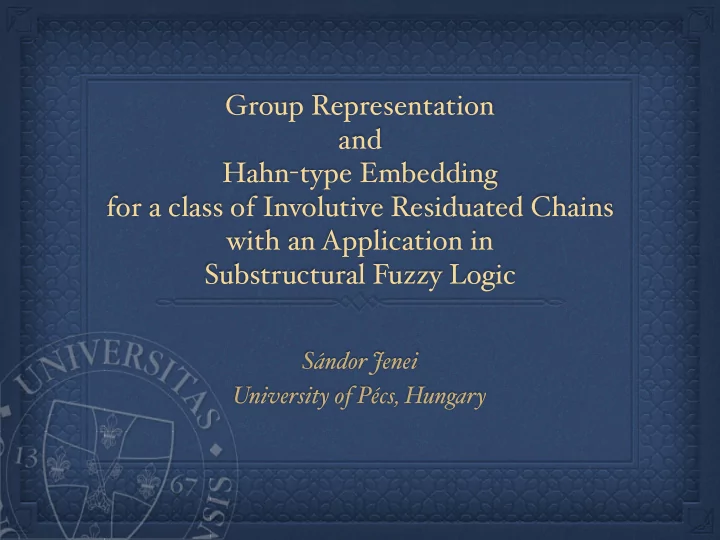

Group Representation and Hahn - type Embedding for a class of Involutive Residuated Chains with an Application in Substructural Fuzzy Logic Sándor Jenei University of Pécs, Hung ary
Substructural Logics Substructural logics encompass among many others, classical logic, intuitionistic logic, relevance logics, many-valued logics, mathematical fuzzy logics, linear logic along with their non-commutative versions. Algebraic counterpart: Residuated Lattices or FL-algebras
FL-algebras An algebra A = ( A, ∧ , ∨ , · , \ , /, 1 , 0) is called a full Lambek algebra or an FL-algebra , if • ( A, ∧ , ∨ ) is a lattice (i.e., ∧ , ∨ are commutative, associative and mu- tually absorptive), • ( A, · , 1) is a monoid (i.e., · is associative, with unit element 1), • x · y ≤ z i ff y ≤ x \ z i ff x ≤ z/y , for all x, y, z ∈ A , • 0 is an arbitrary element of A . Residuated lattices are exactly the 0-free reducts of FL-algebras. So, for an FL-algebra A = ( A, ∧ , ∨ , · , \ , /, 1 , 0), the algebra A r = ( A, ∧ , ∨ , · , \ , /, 1) is a residuated lattice and 0 is an arbitrary element of A . The maps \ and / are called the left and right division . We read x \ y as ‘ x under y ’ and y/x as ‘ y over x ’; in both expressions y is said to be the numerator and x the
Group-like FL e -chains An FL e -algebra is a commutative FL-algebra. An FL e -chain is a totally ordered FL e -algebra. An FL e -algebra is called involutive if x’’= x where x’ = x → f An FL e -algebra is called group-like if it is involutive and f = t (note that f’=t)
Group-like FL e -chains Examples of FL e -chains are f.o. groups or odd Sugihara chains, distinguished by the number of idempotent elements
Relation of group-like FL e -algebras to abelian groups
How to construct? X x Y X 1 ≤ X (X 1 x Y) ∪ ((X ∖ X 1 ) x {.}) X 1 ≤ X (X 1 x Y ⊤ ) ∪ ((X ∖ X 1 ) x { ⊤ }) X 1 ≤ X (X 1 x Y ⊤⊥ ) ∪ ((X ∖ X 1 ) x { ⊥ }) Sufficient to generate densely-ordered algebras
How to construct? X 2 ≤ X 1 ≤ X (X 1 x Y ⊤ ) ∪ ((X ∖ X 1 ) x { ⊤ }) (X 2 x Y) ∪ (X 1 x { ⊤ }) ∪ ((X ∖ X 1 ) x { ⊤ }) X 2 ≤ X 1 ≤ X (X 1 x Y ⊤⊥ ) ∪ ((X ∖ X 1 ) x { ⊥ }) (X 2 x Y) ∪ (X 1 x { ⊤ , ⊥ }) ∪ ((X ∖ X 1 ) x { ⊥ }) Sufficient to generate densely-ordered algebras Sufficient to generate all algebras
How to construct? (details)
How to construct? (details)
It works!
Disconnected vs. Connected PLP construction
Representation by totally ordered Abelian Groups
Representation by totally ordered Abelian Groups
Representation by totally ordered Abelian Groups
Comparison Hahn’s theorem: Our embedding theorem: Every totally ordered Every group-like FL e - Abelian group embeds in chain, which has finitely a lexicographic product many idempotents of real groups. embeds in a finite partial-lexicographic product of totally ordered Abelian groups.
An application in logic
An application in logic
An application in logic
Finite Strong Standard Completeness
Finite Strong Standard Completeness
That is all.
Recommend
More recommend